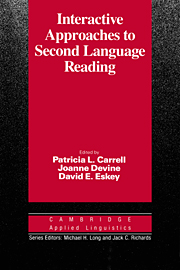Book contents
- Frontmatter
- Contents
- List of contributors
- Series editors' preface
- Preface
- Introduction: Interactive approaches to second language reading
- I INTERACTIVE MODELS OF READING
- Chapter 1 The reading process
- Chapter 2 Models of the reading process
- Chapter 3 A schema-theoretic view of basic processes in reading comprehension
- Chapter 4 Reassessing the term “interactive”
- II INTERACTIVE APPROACHES TO SECOND LANGUAGE READING – THEORY
- III INTERACTIVE APPROACHES TO SECOND LANGUAGE READING – EMPIRICAL STUDIES
- IV IMPLICATIONS AND APPLICATIONS OF INTERACTIVE APPROACHES TO SECOND LANGUAGE READING – PEDAGOGY
- Index
Chapter 4 - Reassessing the term “interactive”
Published online by Cambridge University Press: 05 October 2012
- Frontmatter
- Contents
- List of contributors
- Series editors' preface
- Preface
- Introduction: Interactive approaches to second language reading
- I INTERACTIVE MODELS OF READING
- Chapter 1 The reading process
- Chapter 2 Models of the reading process
- Chapter 3 A schema-theoretic view of basic processes in reading comprehension
- Chapter 4 Reassessing the term “interactive”
- II INTERACTIVE APPROACHES TO SECOND LANGUAGE READING – THEORY
- III INTERACTIVE APPROACHES TO SECOND LANGUAGE READING – EMPIRICAL STUDIES
- IV IMPLICATIONS AND APPLICATIONS OF INTERACTIVE APPROACHES TO SECOND LANGUAGE READING – PEDAGOGY
- Index
Summary
Throughout much of the ESL reading literature the use of the word interactive proliferates. Such a proliferation, however, has tended to obscure the importance that should be attributed to its more technical uses. The purpose of this chapter is to clarify relationships among the uses of the term interactive as it occurs in ESL reading research, first language reading research, and research on written texts. Later sections of this chapter will establish a distinction between the concepts “interactive process” and “interactive model” as they are used in reading research. Lastly, I will introduce a somewhat more exploratory use of the notion of interaction, that of “textual interaction,” as it is being developed in a number of research studies by Biber and Grabe. How productive these distinct conceptions of the word interactive become depends, in large part, on future research.
Reading as an interactive process
In the last ten years, the accepted theory of ESL reading has changed dramatically, from a serial (or bottom-up) model, to “reading as an interactive process.” Widdowson (1979) has discussed reading in this light as the process of combining textual information with the information a reader brings to a text. In this view the reading process is not simply a matter of extracting information from the text. Rather, it is one in which the reading activates a range of knowledge in the reader's mind that he or she uses, and that, in turn, may be refined and extended by the new information supplied by the text.
- Type
- Chapter
- Information
- Interactive Approaches to Second Language Reading , pp. 56 - 70Publisher: Cambridge University PressPrint publication year: 1988
- 31
- Cited by

